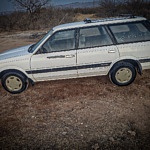Generous Power
The rotary engine was lauded for its compact size, generous power output, and simplicity. German engineer Felix Wankel developed the rotary engine in the postwar era. Automakers worldwide licensed the technology.
Unlike a traditional piston engine in which the pistons move up and down, the rotary’s internals spin continuously in one direction. It requires fewer parts as a result, and those parts rev incredibly fast. The simple architecture allows the rotary engine to produce the same horsepower as a piston engine from much less displacement.
There was only one problem. The apex seals that were points of contact as the rotor spun in its housing and separated one chamber from another were prone to failure. After devoting 47 engineers to the project, Mazda figured out the solution by using graphite. It was durable enough to withstand the high temperatures inside the engine, but soft enough not to damage the housings.
In Every Vehicle
Mazda soon put the new engine in every type of vehicle in its lineup, starting in the 1960s with the Cosmo Sport sports car, followed by the R130 luxury coupe and the R100 compact. None was particularly well suited for the US market, which Mazda was preparing to enter at the time.
In 1970, Mazda put the rotary engine into the midsize Capella sedan and coupe. To distinguish the rotary-powered versions, the company renamed it the RX-2 when introducing it to the US. The rotary displaced only 1,146 cc, yet it generated 120 metric horsepower (118 gross horsepower, 97 net) and 116 pound-feet of torque. That was an exceptional figure for a Japanese car at the time. For comparison, the 1,586-cc piston engine in the 616 made only 74 horsepower.
It was the first mass-market rotary car sold in significant numbers. Its performance was so impressive that Car and Driver magazine built a race car out of it. Motor Trend praised its spacious cabin and ergonomics while saying it could “make mincemeat of a BMW 2002,” the gold standard for sports sedans at the time.
Shop now for OEM RX-2 partsAmazing Survivor
The car for sale is an amazing survivor. Due to the RX-2’s performance potential and the presumed disposability of Japanese cars of the era, many were turned into race cars or cannibalized for their rotary engines. Original RX-2s that haven’t been abused are exceedingly rare. This car claims only 50,000 original miles on its five-digit odometer.
Emblematic of how difficult it is to find an all-original example, the car is missing its factory center console, front seats, and steering wheel. The wheels have been replaced with common, wider aftermarket units. The car has a period-correct air cleaner and exhaust by Mazda tuning shop, Racing Beat.
Despite its minor flaws, you’d be hard pressed to find an RX-2 as original as this at any classic car show. Its $32,500 Buy-It-Now price reflects the originality and rarity of such a find.
Shop now for RX-2 parts




